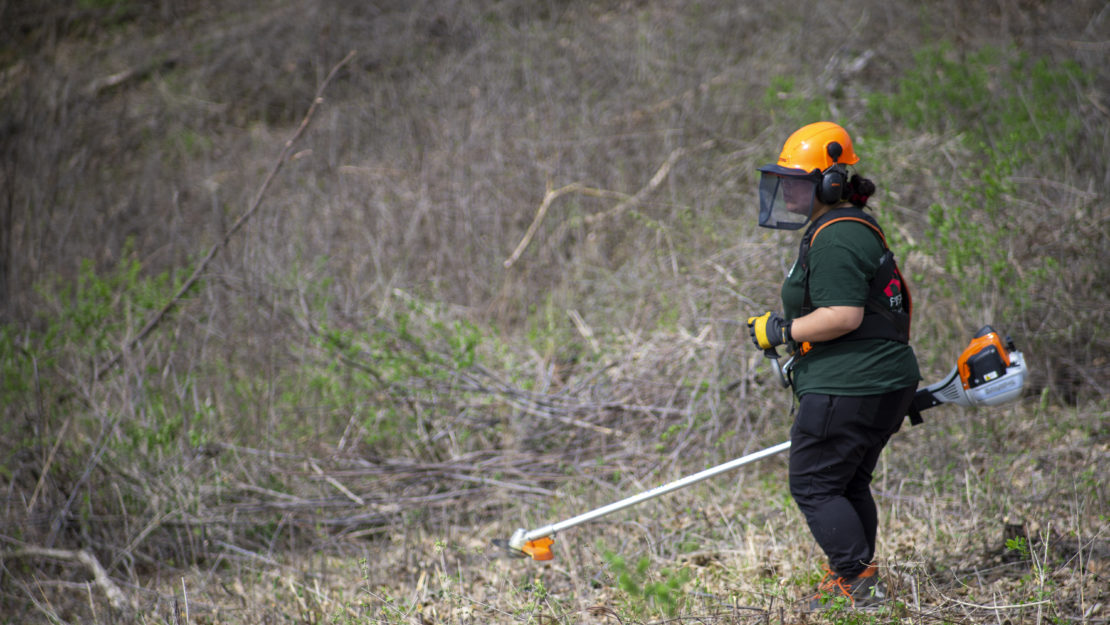Talking Story with Mary Metchnek

This Asian American and Pacific Islander Heritage Month, we reached out to collaborate with and share stories from AAPI members of our outdoors community. We went out for a day with Central Field Specialist, Mary Metchnek, to hear her story.
Transcript of video:
Storytelling to me is really important because that’s how people connect with each other, and it’s how, I feel like it’s how you can connect to most things. Stories that of the land, of like, certain, you know, plants and animals. That they can connect you in that sense and also connect you to your ancestors. There’s just so many different ways a story and storytelling is so impactful to people. When you want to get to know someone, that’s the easiest way, is for them to tell you their story.
Hello, I’m Mary. I’m the field specialist for Central District, Conservation Corps Minnesota & Iowa. Currently, we’re out with the MN Valley crew at an oak savanna restoration prairie. We’re just kind of clearing some invasive shrubs and everything to get some breathing room for the burr oak and so that it can be a savanna again.
Some of my favorite memories happen while we’re on spike, which is where we go and camp near the site that we’re going to be working at. And I personally really enjoyed being out Father Hennepin, because it’s right next to a really big lake, which reminds me of home. We get to sleep in a tent near some wave sounds.
When I was back living in Hilo, Hawaiʻi, so I was part of the PIPES Program and we they kind of partnered with Kupu, which is the Hawaiʻi version of the Corps. I was giving the amazing opportunity to work in a Loko i`a, which is a traditional Hawaiʻian fishpond. And there I was able to do restoration projects. I had a lot of education activities, learning about, you know, restoration and learning about the importance of natural resources for the kids. But then it was also just an amazing experience for me because I basically learned what I wanted to do, which was be a Kiaʻi for a Loko i`a, which is a steward for like the fish ponds. And yeah, that’s my short term as part of Kupu.
I wanted to share my story because I want other folks of color to see that, and see that, you know, being in the natural resources field in the Corps can be a safe space for that. No, I, I notice that, you know, I seen like other staff of color in positions of leadership and that kind of led me to kind of be like, Oh, hey, they’re doing that, I can do that too then. And I think it’s important for others to see. That was really impactful for me. So I kind of am hoping that others seeing me in a position of leadership, for instance, you know, being a field specialist and going around and helping the crews can, you know, kind of help others be like, well, hey, I can do that, too.
And it’s really important for me as an Asian-American in natural resources, for others who want to be in natural resources to, you know, get the stepping stones that they need and get the support they need. It’s not just for like certain people. It’s for everyone because this is everybody’s. Natural resources is for everybody.
From my first year in 2020 versus this year, like it looks a lot different. Just like with whoever is coming into the Corps and you know, that means the Corps is a safe space. Like we’re creating a safe space for BIPOC folk, for just like, everyone to be in this space. That to me, that means something, you know, coming from my first crew lead year, being the only person of color as a crew lead. And then the progression from that year of seeing who’s coming into the Corps, who’s staying, who is becoming, you know, coming up in leadership roles, like it’s… I don’t know, makes me feel like I’m wanted here and that I can be here and then I can be safe here.
One thing that I know I’m trying to figure out for myself is at what point do you become a token for an organization and what point are you just being genuinely represented in an organization?
When we talk about being genuine and representing oneself as being a person of color in an organization that might not always be, you know, seen as that, I think part of being in, you know, being genuine is telling your story. Like who, who are you? Because you know, I could be like, oh, I’m Mary. You know, to my knowledge, I’m Filipino, Korean, and most likely, you know, bunch of other Asian stuff, mixed plate. It can be like just that. That’s like the surface level, what a lot of people will see when they, you know, are from the outside. But then when you actually start telling more of your story, you get into that storytelling of who you actually are. Then it’s I feel like it’s more genuine and you get to know that person and be like, oh, that’s a real person. And this is what they’re doing in the natural resources field. Like it just, I think it’s important for people to hear, see that, and read about it.
You know, if you’re interested in outdoors, come hang out with us. Or, you know. Yeah, just come hang out with us. Talk story.